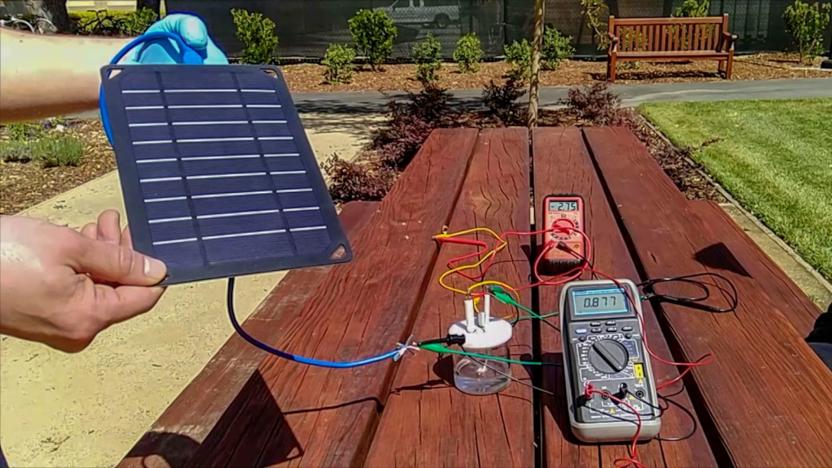saltwater
Latest

Scientists can turn regular seawater into hydrogen fuel
A team of scientists at Stanford have figured out a way to make hydrogen fuel out of saltwater. The discovery could open up the world's oceans as a potential source of energy. Researchers view electrolysis, or the act of splitting water into hydrogen and gas, as a promising new source of renewable energy. But it comes with many roadblocks; a major one being that only purified water can be used in electrolysis. Seawater tends to corrode water-splitting systems.

Green House's lantern runs on salt and water, powers your gadgets via USB
Japanese company Green House Co Ltd has quite an eclectic product portfolio, what with its women-only camcorder and peripherals like a PCI Express interface card with USB 3.0 support. Its latest device falls under another category entirely: the rivetingly named GH-LED10WBW is an LED lantern that runs on just water and salt; no batteries required. The light source provides eight hours of electricity per dose of saline water, and the lantern comes with a dedicated water bag for mixing the solution. The salt / water combo acts as an electrolyte with the magnesium (negative electrode) and carbon (positive electrode) rods inside the lantern. Users can get about 120 hours of power with the Mg rod before they'll need to buy a replacement (the rod is sold separately to begin with). More than just supplying a battery-free source of light, though, the lantern can function as a charger, thanks to a USB port built into the casing. Pricing has yet to be announced, but the GH-LED10WBW will be available by mid-September.

Microbial fuel cell produces hydrogen from wastewater without wasting energy
Back in 2005, Bruce Logan and his team of Penn State researchers developed a microbial fuel cell capable of converting poop into power. Now, Logan has refined his system to the point where it can produce hydrogen from wastewater or biodegradable organic materials without using a drop of grid electricity, and without emitting even a hint of carbon dioxide. His approach, outlined in the September 19th issue of the Proceedings of the National Academy of Sciences, involves something known as reverse-electrodialysis (RED) -- a process that harvests energy from the ionic discrepancy between fresh and salt water. Logan's bacterial hydrolysis cell (pictured left) features a so-called RED stack that's comprised of alternating positive and negative ion exchange membranes, which it uses to split water molecules into hydrogen and oxygen. Normally, this process would involve about 25 pairs of membranes, but by using RED technology in conjunction with electricity-producing exoelectrogenic bacteria, Penn State's team was able to extract hydrogen with just five membrane pairs. All told, Logan's cells proved to be about 58 to 64 percent energy efficient, while producing between 0.8 to 1.6 cubic meters of hydrogen for every cubic meter of liquid that passed through the system. The researchers' results show that only one percent of that energy was used to pump water through the cells, which are completely carbon neutral, as well. According to Logan, this breakthrough demonstrates that "pure hydrogen gas can efficiently be produced from virtually limitless supplies of seawater and river water and biodegradable organic matter." Somewhere, the US Navy is taking scrupulous notes. Full PR after the break. [Image courtesy of Penn State / Bruce Logan]

Google opening seawater-cooled data center, finally glad it applied for that Wave trademark (video)
Google raised a few eyebrows when it purchased a Finnish paper mill back in 2009 -- what, the world, wondered, would the king of cloud services want with reams of tree guts? Space for a data center, of course -- and a seawater-cooled one at that. Google's Joe Kava told GigaOm that, when it launches in the fall, the center's temperature will be regulated by a quarter-mile of seawater tunnels inherited from the building's past tenants. One of the hardest parts of getting the system up and running has apparently been figuring out a way to clean corrosion from salt water without taking the system offline. Google's also working to limit the center's impact on the surrounding ecosystem, making sure that the water itself is cooled down before being pumped back out. Between this and those wind-powered data centers, it looks like Captain Planet's always got a cushy IT gig at Google to fall back on, should he ever fall on hard times.

Can saltwater be burned as fuel?
A gentleman from Erie named John Kanzius made a somewhat "shocking" discovery while he was working on a radio-wave generator he had developed for the treatment of cancer. While attempting to desalinate sea water using radio frequencies, he noticed flashes, and within a few days, had saltwater burning in a test-tube as if it were a candle. The discovery spawned interest from the scientific community, mostly concerned with whether or not the water could be used as a fuel, and of course, healthy doses of disbelief. Last week, a Penn State University chemist named Rustum Roy held a demonstration proving that the science is sound, noting that the water doesn't burn, though the radio frequencies weaken the bonds holding together the salt, releasing hydrogen which is ignited when exposed to the RF field. Mr. Kanzius and Dr. Roy say the question now is the efficiency of the energy, and are presenting the technology to the US Department of Defense and Department of Energy to investigate how useful the technology will be. Of the plentiful maybe-fuel (which apparently burns so hot it can melt test-tubes) Dr. Roy says, "This is the most abundant element in the world. It is everywhere," and (without recognition of the poetic irony, as far as we can tell), "Seeing it burn gives me chills." Check the TV report after the break to see the water in action.[Thanks, Paul]



